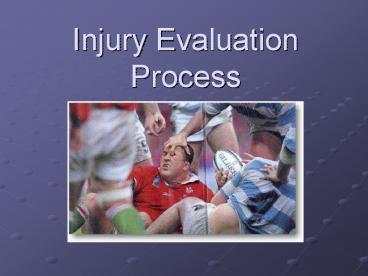Injury Evaluation Process - PowerPoint PPT Presentation
1 / 17
Title:
Injury Evaluation Process
Description:
Palpation. Tell athlete it may hurt, and why. Begin gently and gradually increase pressure. Correlate athletes reactions to structures palpated ... – PowerPoint PPT presentation
Number of Views:102
Avg rating:3.0/5.0
Title: Injury Evaluation Process
1
Injury Evaluation Process
2
Why have a process for evaluation?
3
On-Field Assessment
- Instruct coaches and athletes not to move an
injured athlete. - Know the rules regarding on field assessment
- Goals and Purposes
- Rule out life-threatening/serious injuries
- Determine the sight and severity
- Determine the method of transport
4
On-Field Assessment
- Primary Survey
- Secondary Survey
- History
- Observation
- Screening
- Immediate Action Plan
5
On-Field Assessment
- Primary Survey
- Airway, Breathing, Circulation
- Try to arouse if unconscious
- Treat for neck injury if you did not see the
injury
6
On-Field Assessment
- Secondary Survey
- History
- Mechanism of injury
- Location of the injury
- Severity of injury
- Observation
- Abnormal positioning of the head, neck, or
extremities - How is the athlete reacting to the injury?
- Does the athlete have bleeding from the head or
other signs of head injury? - Observe for internal injuries
- Deformity, swelling, or discoloration of the
extremities. - Asses for Shock
- Pale, cool, clammy skin, rapid and shallow
breathing, weak and rapid pulse, nausea, falling
blood pressure.
7
On-Field Assessment
- Screening
- Rapid evaluation techniques
- Immediate Action Plan
- If injury is serious or life-threatening, EMS
- If not serious or life-threatening, transport off
field for more detailed assessment off the field.
- Sensory and motor testing for suspected
spinal/nerve injury. - Neurovascular tests for suspected
fracture/dislocation - Assessment for head injury if suspected
- Orthopedic assessment
- Palpation
- ROM and strength screen
- Special tests
- Continued monitoring for shock
8
Off-Field Athletic Injury Assessment
- HOPS
- History of the injury
- Check life threatening situations
- History of the injury
- History of the individual
- Observation and Inspection
- Visual inspection
- Palpation
- Hands on inspection
- Special Tests
- Test structural integrity
- Functional activity tests
9
SUMMARY OF THE ATHLETIC INJURY EVALUATION PROCESS
- Check life threatening situations
- (deal with problems immediately of present)
- Consciousness
- ABCs airway, breathing, Circulation
- Cervical spine
- Traumatic shock
10
SUMMARY OF THE ATHLETIC INJURY EVALUATION PROCESS
- History of the injury
- Most underrated and overlooked aspect of
evaluation - Where does it hurt? (have athlete point to it)
- When did it happen?
- Sudden or gradual
- How did it happen?
- If hit, how?
- Position of body part when, and after, it
happened?
11
SUMMARY OF THE ATHLETIC INJURY EVALUATION PROCESS
- History of the individual
- Former injuries? (when, how occurred, see
physician, what rehab, etc.) - Level of training? (when start, when and how
much increase)
12
SUMMARY OF THE ATHLETIC INJURY EVALUATION PROCESS
- Observation
- Position of body
- Look for swelling, deformity, skin coloration,
muscle spasm, eye movement, facial expression - Compare opposite sides of body
13
SUMMARY OF THE ATHLETIC INJURY EVALUATION PROCESS
- Palpation
- Tell athlete it may hurt, and why
- Begin gently and gradually increase pressure
- Correlate athletes reactions to structures
palpated - Start away from suspected injury and gradually
work toward it
14
SUMMARY OF THE ATHLETIC INJURY EVALUATION PROCESS
- Test Structural Integrity
- Nerves sensory and motor
- Circulation Feel pulse in injured body part
- Musculoskeletal look for abnormal range of
motion and/or pain in and around both injured and
surrounding joints. - Active ROM athletes voluntary movements
- Passive ROM athletic trainer provides movement
- Resistive ROM athletic trainer provides
resistance - Special tests
15
SUMMARY OF THE ATHLETIC INJURY EVALUATION PROCESS
- Functional Activity Tests
- Use only for mild injuries
- Use the injured body part to perform skill
- Begin with very simple skills (walking, reaching,
etc.) and progress to very complex skills
(running and cutting, etc.) - Begin each skill and half speed and progress to
full speed - Do not allow any activity that causes pain
- Determine if athlete can perform normally
- Observe performance, looking for smooth, fluid
motion - Question athlete concerning pain or other
abnormal feeling.
16
SUMMARY OF THE ATHLETIC INJURY EVALUATION PROCESS
- Make a decision concerning the nature and
severity of the injury - Draw together all of the previous evidence
- Based on the decision, use any or all of the
following procedures that are dictated by the
situation. - Apply emergency first aid
- Allow the athlete to continue participation
- I.C.E. and rest
- Refer to Physician
- Confirm evaluation
- X-ray and lab test
- Recommend/administer definitive treatment
17
SUMMARY OF THE ATHLETIC INJURY EVALUATION PROCESS
- Re-evaluate
- Throughout rehabilitation
- Record Findings

